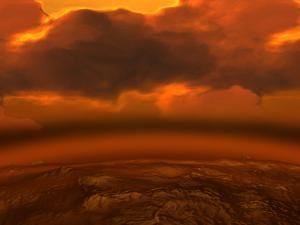This artist's concept shows the skies of Venus, the hottest planet in the solar system. Although it is farther from the Sun than Mercury is, Venus's peak temperatures are more than 100 degrees Fahrenheit higher than Mercury's. Venus's dense carbon-dioxide atmosphere traps solar heat, kicking its temperatures up a notch. And Venus maintains those temperatures across the planet, both day and night, whereas Mercury's peak temperatures are recorded around local noon at the equator, with other regions of the planet not nearly as hot. Venus and Mercury appear together in the early evening sky for the final few nights of 2021. Venus is the Evening Star, with fainter Mercury climbing past it. [ESA]
You are here
Venus and Mercury
The Sun’s closest planets are crossing paths in the southwest in early evening. There’s a limited viewing window because they set by the time twilight fades away.
The brighter planet is Venus. It’s the “evening star,” quite low in the sky at sunset. It’s so bright that you might mistake it for an airplane with its landing lights turned on. But it’s so low that you need a clear horizon to pick it out — any trees or buildings will block it from view.
Mercury stands a little to the lower left of Venus this evening, but it’s moving upward. It’ll be roughly even with Venus tomorrow evening, then will move up and away from it. It’ll stand a little higher in the sky at sunset for several days.
Mercury is the closest planet to the Sun, while Venus is the next one out. Yet Venus is much hotter. That’s because it has a thick atmosphere, made mainly of carbon dioxide. As we know from our changing climate here on Earth, C-O-2 is a potent greenhouse gas — it traps heat. It’s warmed the surface of Venus to more than 850 degrees Fahrenheit.
By comparison, peak temperatures on Mercury — which has no atmosphere to speak of — are about a hundred degrees lower. And most of the time, across most of the planet, it’s not nearly as hot. It can reach hundreds of degrees below zero on the nightside and at the poles — frigid conditions close to the Sun.
Keep an eye on these close, hot worlds as they cross paths in the early evening sky.
Script by Damond Benningfield
Get Premium Audio
Listen to today's episode of StarDate on the web the same day it airs in high-quality streaming audio without any extra ads or announcements. Choose a $8 one-month pass, or listen every day for a year for just $30.



